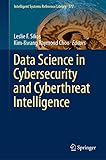Data science in cybersecurity and cyberthreat intelligence / Leslie F. Sikos, Kim-Kwang Raymond Choo, editors
Material type: TextSeries: Intelligent systems reference library ; v. 177Cham : Springer International Publishing, c2020Description: xii, 129 pages : illustration (some color) ; 24 cmISBN: 9783030387877 (hardcover); 3030387879 (hardcover)Subject(s): Computer securityLOC classification: QA76.9.A25 | D38 2020Summary: This book presents a collection of state-of-the-art approaches to utilizing machine learning, formal knowledge bases and rule sets, and semantic reasoning to detect attacks on communication networks, including IoT infrastructures, to automate malicious code detection, to efficiently predict cyberattacks in enterprises, to identify malicious URLs and DGA-generated domain names, and to improve the security of mHealth wearables. This book details how analyzing the likelihood of vulnerability exploitation using machine learning classifiers can offer an alternative to traditional penetration testing solutions. In addition, the book describes a range of techniques that support data aggregation and data fusion to automate data-driven analytics in cyberthreat intelligence, allowing complex and previously unknown cyberthreats to be identified and classified, and countermeasures to be incorporated in novel incident response and intrusion detection mechanisms
TextSeries: Intelligent systems reference library ; v. 177Cham : Springer International Publishing, c2020Description: xii, 129 pages : illustration (some color) ; 24 cmISBN: 9783030387877 (hardcover); 3030387879 (hardcover)Subject(s): Computer securityLOC classification: QA76.9.A25 | D38 2020Summary: This book presents a collection of state-of-the-art approaches to utilizing machine learning, formal knowledge bases and rule sets, and semantic reasoning to detect attacks on communication networks, including IoT infrastructures, to automate malicious code detection, to efficiently predict cyberattacks in enterprises, to identify malicious URLs and DGA-generated domain names, and to improve the security of mHealth wearables. This book details how analyzing the likelihood of vulnerability exploitation using machine learning classifiers can offer an alternative to traditional penetration testing solutions. In addition, the book describes a range of techniques that support data aggregation and data fusion to automate data-driven analytics in cyberthreat intelligence, allowing complex and previously unknown cyberthreats to be identified and classified, and countermeasures to be incorporated in novel incident response and intrusion detection mechanisms
| Item type | Current library | Collection | Call number | Copy number | Status | Date due | Barcode |
|---|---|---|---|---|---|---|---|
 General Circulation
General Circulation
|
APU Library Open Shelf | Book | QA76.9 .A25 D38 2020 c.1 (Browse shelf (Opens below)) | 1 | Available | 00012862 |
Includes bibliographical references.
This book presents a collection of state-of-the-art approaches to utilizing machine learning, formal knowledge bases and rule sets, and semantic reasoning to detect attacks on communication networks, including IoT infrastructures, to automate malicious code detection, to efficiently predict cyberattacks in enterprises, to identify malicious URLs and DGA-generated domain names, and to improve the security of mHealth wearables. This book details how analyzing the likelihood of vulnerability exploitation using machine learning classifiers can offer an alternative to traditional penetration testing solutions. In addition, the book describes a range of techniques that support data aggregation and data fusion to automate data-driven analytics in cyberthreat intelligence, allowing complex and previously unknown cyberthreats to be identified and classified, and countermeasures to be incorporated in novel incident response and intrusion detection mechanisms


There are no comments on this title.